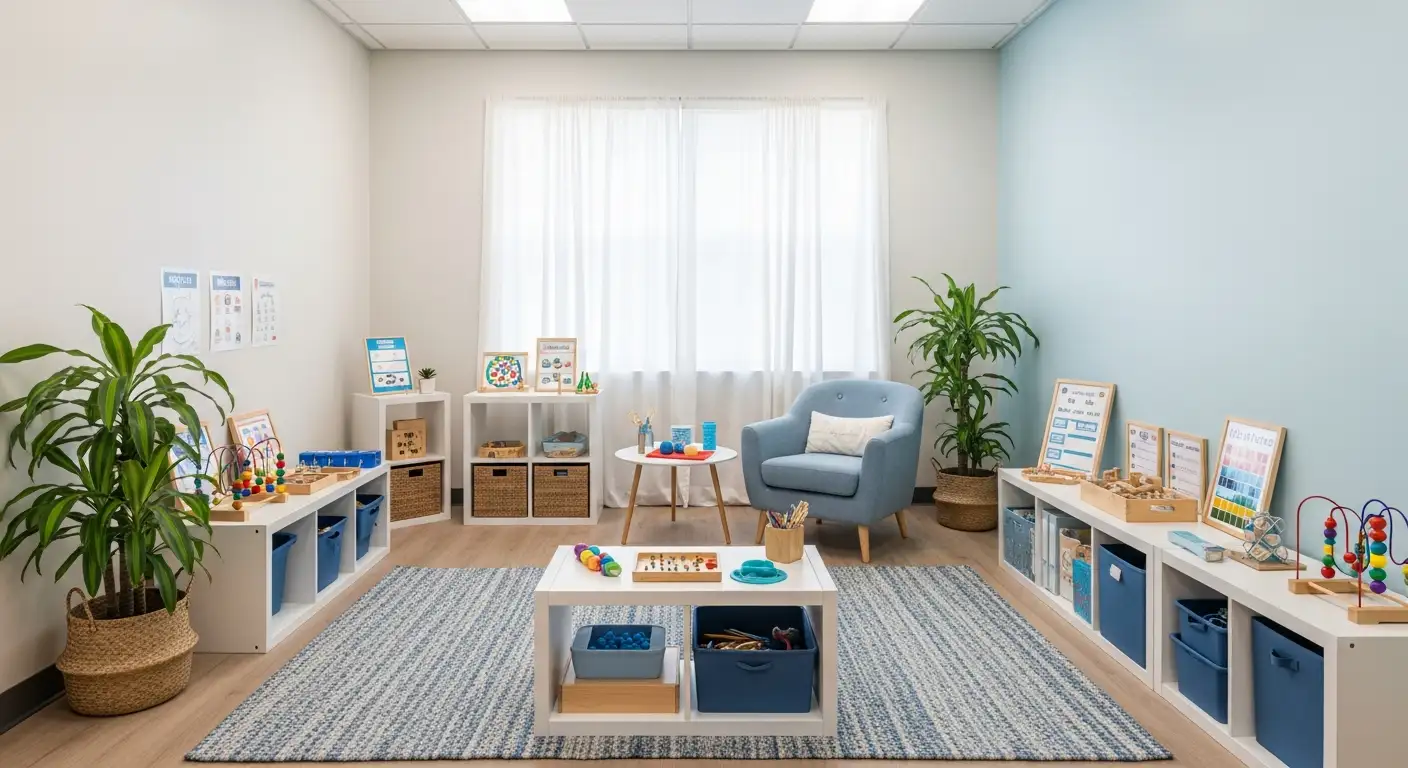Understanding the Impact of Behavioral Therapy on Language Development in Autism
Behavioral therapy, especially Applied Behavior Analysis (ABA), has become a cornerstone in supporting children with autism in developing essential communication skills. By applying scientifically validated techniques, therapists and parents can foster meaningful improvements in language abilities, facilitating better social interaction and independence. This article explores the role of behavioral therapy in language development, the specific methods used, and the evidence supporting these approaches.
The Foundations of Behavioral Therapy in Autism Support

What is the role of behavioral therapy, including Applied Behavior Analysis (ABA), in supporting language development in individuals with autism?
Behavioral therapy, especially Applied Behavior Analysis (ABA), is fundamental in helping children and adults with autism improve their communication skills. This approach is rooted in the science of learning and behavior, using structured techniques to teach language and social skills.
At its core, ABA focuses on understanding the functions of behaviors, then teaching new, helpful behaviors while reducing harmful ones. It employs methods such as positive reinforcement, prompting, shaping, and chaining to encourage communication.
For language development, ABA incorporates various strategies. Discrete Trial Training (DTT) uses step-by-step instructions with rewards to teach vocabulary and sentence structure. Natural environment teaching and incidental teaching motivate children to communicate during everyday activities.
Specific ABA-based therapies like Pivotal Response Treatment (PRT) emphasize natural play and social interactions, targeting pivotal skills like motivation and initiation of communication. Verbal Behavior Therapy categorizes language skills into operants such as mands (requests), tacts (comments), and echoics (imitation), helping children develop functional speech.
Early, intensive, and individualized ABA programs often involve both trained therapists and family members. This teamwork ensures consistent teaching and reinforcement across settings, which is critical for success.
Research consistently supports ABA’s effectiveness in enhancing language skills among individuals with autism. These interventions are tailored to each child’s specific needs and may include augmentative and alternative communication (AAC) systems like picture exchange (PECS) or speech-generating devices.
Overall, ABA-based techniques significantly contribute to improving functional communication, increasing independence, and reducing barriers to social interaction for individuals with autism.
Techniques and Principles of Behavioral Therapy for Communication Enhancement

What techniques and principles are used in behavioral therapy to enhance communication skills for children with autism?
Behavioral therapy employs a variety of strategies grounded in the science of learning and behavior. Positive reinforcement is a core method, where children receive praise, tokens, or rewards immediately after a desired communication behavior, encouraging repetition.
Prompting is another essential technique; it involves guiding the child to use a communication skill through physical, verbal, or visual cues. Shaping gradually reinforces closer approximations of the desired behavior, shaping complex communication skills over time.
Discrete Trial Training (DTT) and Pivotal Response Training (PRT) are structured approaches used within Applied Behavior Analysis (ABA). DTT involves breaking down skills into small, manageable steps, teaching them through repetitive trials, and reinforcing success. PRT emphasizes natural settings, focusing on pivotal skills like motivation and initiating communication, which lead to broader improvements in language and social behaviors.
In addition to structured methods, naturalistic teaching strategies such as incidental teaching involve spontaneous interactions during everyday activities. Trainers or caregivers prompt the child to communicate in real-life situations, making learning more meaningful.
Augmentative and Alternative Communication (AAC) systems are vital for children with speech delays. These include picture exchange systems (PECS), sign language, speech-generating devices, and visual supports that facilitate expression and comprehension.
Role-playing, social stories, and visual aids are employed to reinforce communication in engaging ways. These strategies help children understand social cues, practice pragmatics, and gain confidence in using language.
Early, individualized intervention is crucial. Combining behavioral principles with speech therapy techniques—like modeling, imitation, and prompting—along with active participation from parents and educators, significantly enhances communication outcomes for children with autism. These methods create a supportive environment that promotes spontaneous, functional communication skills, laying the foundation for improved social integration and independence.
Research Evidence Supporting Behavioral Strategies for Language Improvement
What evidence exists that demonstrates the effectiveness of behavioral therapy in improving language skills in autistic individuals?
Research consistently shows that behavioral therapy, especially Applied Behavior Analysis (ABA), plays a crucial role in advancing language abilities for children with autism. Multiple studies indicate that intensive and early ABA interventions lead to significant improvements in both receptive and expressive language skills.
Standardized assessment tools like the Receptive and Expressive Language Evaluation Scale (REELS) and the Vineland Social Maturity Scale are often used to measure progress in communication. These assessments have documented observable gains in how children understand and use language after undergoing ABA therapy.
Meta-analyses pooling data from various studies reinforce these findings. They reveal that approximately 63% to 88% of research reports positive effects of ABA on language development. Notably, children who receive early, consistent, and long-term ABA treatment tend to show the most substantial improvements.
Long-term outcomes also support ABA's effectiveness. Children who start therapy early, typically under age six, demonstrate better language acquisition and social communication skills. This is aligned with brain plasticity during early childhood, making interventions more impactful.
In summary, the evidence base robustly affirms that behavioral therapies like ABA are effective strategies for boosting language skills, emphasizing the importance of early and ongoing intervention.
Methods and Strategies to Promote Language Acquisition

What are some methods and intervention strategies within behavioral therapy aimed at fostering language acquisition and communication?
Behavioral therapy for promoting language and communication skills uses a variety of structured and naturalistic approaches. Among the most well-known methods are Discrete Trial Training (DTT), Natural Environment Teaching (NET), and the use of modeling and visual supports.
Discrete Trial Training (DTT) involves breaking down skills into small, manageable steps. It uses clear instructions, prompts, and immediate reinforcement to teach vocabulary, sentence structure, and conversational skills. This method ensures systematic repetition, helping children learn language in a consistent, predictable way.
Natural Environment Teaching (NET) takes a different angle by embedding language learning within everyday routines and natural interactions. The goal is to make language use meaningful and functional, encouraging spontaneous communication in real-life situations. Children are prompted and supported during play, mealtime, or other daily activities.
Modeling and visual supports are core components of ABA strategies. By demonstrating correct usage of words or gestures and providing visual cues like picture schedules or communication boards, therapy helps children understand and imitate language more effectively. These supports are especially useful for children with limited speech or nonverbal communication.
The applied verbal behavior (AVB) approach categorizes language into operants such as mands (requests), tacts (labels), and intraverbals (conversational responses). Teaching these functional language forms encourages children to communicate their needs, label objects, and participate in conversations.
Procedures like Incidental Teaching, Mand-Model, and Pivotal Response Training (PRT) emphasize natural, child-initiated interactions. For example, Incidental Teaching prompts children to name objects or ask questions during daily activities, fostering motivation and generalization.
Reinforcement strategies are integral, with children encouraged to use language through praise, tokens, or other rewards. Visual supports, including schedules and cue cards, help reduce anxiety and improve comprehension.
Overall, these methods are designed to make language learning engaging and relevant to each child's interests, significantly enhancing their ability to communicate effectively.
| Technique | Description | Focus | Effectiveness | Additional Details |
|---|---|---|---|---|
| DTT | Structured, step-by-step instruction | Vocabulary, syntax | High | Repetition and reinforcement drive learning |
| NET | Embedding learning in natural routines | Spontaneous language | Promotes generalization | Uses play, daily activities |
| Modeling & Visual Supports | Demonstrating language use, visual cues | Comprehension & use | Facilitates imitation | Supports nonverbal communication |
| Incidental Teaching | Natural interactions, child-initiated prompts | Functional communication | Encourages initiation | Based on child's interests |
Comparison and Synergy with Speech and Language Therapy

How does behavioral therapy compare or complement speech and language therapy for individuals with autism?
Behavioral therapy, especially applied behavior analysis (ABA), and speech and language therapy are often used together to support individuals with autism. While each has distinct goals, they work well in tandem to improve communication and social skills.
Speech and language therapy primarily focuses on enhancing understanding of language, improving speech clarity, and teaching alternative ways to communicate, such as using augmentative and alternative communication (AAC) devices. It targets specific language skills like vocabulary, sentence structure, and understanding social cues.
ABA, on the other hand, aims to modify behavior by understanding what triggers certain actions and reinforcing positive behaviors. It can help reduce problematic behaviors and promote functional communication by using techniques like reinforcement, prompting, and modeling.
When combined, these therapies provide a comprehensive approach. For instance, ABA can reinforce speech therapy goals by rewarding attempts at communication, helping children use words or gestures more consistently. This integration supports generalization of skills in various settings, whether at home, school, or social environments.
Skills targeted and methods used
Speech therapy tends to focus on:
- Language comprehension
- Speech clarity
- Use of gestures and AAC
- Social language skills
ABA methods often involve:
- Positive reinforcement
- Discrete Trial Training (DTT)
- Pivotal Response Treatment (PRT)
- Natural environment teaching
Both therapies emphasize data collection to measure progress and adjust strategies accordingly. For example, speech therapists might work on specific vocabulary, while ABA therapists reinforce the use of that vocabulary during everyday interactions.
Integrated approaches for optimal outcomes
Health professionals recommend integrating ABA and speech therapy early on for the best results. This combined effort can improve not only language abilities but also social interactions, adaptive skills, and behavior management.
Educational settings increasingly adopt models where therapists collaborate, sharing insights and strategies. This teamwork ensures that interventions are aligned with the child's evolving needs.
In summary, combining ABA techniques with speech and language therapy creates a more effective, personalized intervention plan. This synergy can significantly enhance communication skills and overall development for individuals with autism.
The Role of Caregivers and Home Strategies in Language Development

How can parents and caregivers support language development at home through behavioral strategies?
Parents and caregivers play a crucial role in reinforcing and extending the gains achieved through professional ABA therapy. They can support language growth by creating consistent opportunities for communication during everyday routines and interactions. Engaging children in play, imitation, and social activities encourages natural language use.
Visual supports are valuable tools for fostering understanding and expression. These include picture Exchange Communication System (PECS), visual schedules, and timers, which help children grasp routines and communicate their needs more effectively.
Positive reinforcement techniques, such as praising efforts or providing tokens, motivate children to attempt using language. Reinforcement should be immediate and meaningful to reinforce desired behaviors.
Practicing joint attention—where the caregiver and child focus on the same object or activity—serves as a foundation for language learning. Modeling appropriate speech and expanding on the child's attempts further facilitates language development.
For children who are nonverbal or have limited speech, assistive technologies like speech-generating devices and augmentative and alternative communication (AAC) systems can provide alternative ways to communicate.
Training caregivers in behavioral support strategies, including prompting, shaping, and reinforcing, ensures consistency across different environments. This consistency consolidates skills learned during therapy.
By working closely with professionals and maintaining a supportive, language-rich environment at home, parents and caregivers can significantly contribute to their child's ongoing language development, helping them achieve better communication, social, and daily living skills.
Integration of Multidisciplinary Approaches and Future Directions

How does combining ABA with occupational and sensory therapies enhance outcomes?
Integrating Applied Behavior Analysis (ABA) with occupational and sensory therapies offers a comprehensive approach to supporting children with autism. Occupational therapy helps improve daily living skills and physical coordination, while sensory integration therapy addresses sensory processing challenges. When combined, these therapies work synergistically to enhance communication, social skills, and overall independence.
For example, while ABA techniques focus on teaching communication and social behaviors through reinforcement and structured tasks, sensory strategies can help children better tolerate sensory input, making them more receptive to ABA interventions. This integration creates a more individualized treatment plan that addresses a child's specific needs holistically.
Why is early intervention critical?
Early intervention, especially within the first few years of life, maximizes brain plasticity, making it easier for children to develop age-appropriate skills. Intensive ABA therapy during this critical window can lead to significant improvements in language, social, and behavioral areas.
Research indicates that children receiving early treatment show better long-term outcomes, including increased communication skills and reduced behavioral challenges. A multidisciplinary team including behavior analysts, speech therapists, and occupational therapists plays a vital role in delivering effective early intervention.
What are the current developments and future directions?
Ongoing research continues to refine ABA and related therapies. Innovations such as incorporating technology—like speech-generating devices and visual supports—are enhancing communication for nonverbal children. There is also a growing emphasis on integrating naturalistic and play-based interventions, like Pivotal Response Treatment, to make therapy more engaging.
Emerging approaches aim to tailor interventions further based on individual research and biometric data, promising more personalized and effective strategies. As understanding of autism deepens, future treatments are expected to become more seamless, combining behavioral, developmental, and sensory methods to optimize outcomes for individuals across the lifespan.
| Approach | Focus Area | Key Benefit | Innovations |
|---|---|---|---|
| ABA Therapy | Behavior modification, skills teaching | Improves communication, social interaction | Use of technology, virtual reality environments |
| Occupational Therapy | Daily living, motor skills | Enhances independence and sensory regulation | Integration with sensory systems, assistive tech |
| Sensory Integration Therapy | Sensory processing issues | Better sensory tolerance, decreased anxiety | Customized sensory diets, wearable sensors |
| Early Intervention Programs | Developmental support for young children | Long-term cognitive and social gains | Multidisciplinary teams, parent training programs |
This multidisciplinary focus is paving the way for more effective, personalized, and comprehensive autism support systems, promising brighter futures for individuals with autism.
Conclusion

Summarizing the Benefits of Behavioral Therapy
Behavioral interventions, especially applied behavior analysis (ABA), have proven to be highly effective in enhancing language development among children with autism. These therapies systematically teach communication skills using techniques like positive reinforcement, prompting, modeling, and natural environment teaching. As a result, children often experience significant improvements in both expressive and receptive language skills, which are essential for social interaction and independence.
The research underscores that early, intensive, and tailored interventions lead to the best outcomes. Starting therapy at a young age benefits from the brain's heightened plasticity, enabling children to acquire new skills more quickly. ABA also helps reduce problematic behaviors that can hinder communication and learning, creating a conducive environment for language development.
The Significance of Customized, Early Intervention
Individualized programs that address each child's unique needs are critical to successful outcomes. Effective interventions involve detailed assessments and personalized learning plans focused on specific language goals. Early intervention, ideally before the age of six, can significantly influence a child's developmental trajectory. It leverages the brain's natural readiness to learn and adapt, offering children the best chance to develop age-appropriate communication skills.
Working Together Toward Progress
The process of language development benefits from a collaborative effort involving families, clinicians, and educators. Parents' active involvement in creating supportive home environments and daily routines reinforces the skills learned in therapy. Clinicians provide expert guidance, assessments, and ongoing adjustments to intervention strategies. Educators adapt classroom settings to support visual learning and structured routines, fostering a consistent environment across different settings.
This teamwork ensures that skills acquired during therapy transfer seamlessly to everyday life, promoting lasting progress. Combining behavioral strategies with speech and occupational therapies and using visual supports or assistive devices further enhances communication for children with more significant challenges.
Final Thoughts
Research and practical experience affirm that behavioral therapy, particularly ABA, offers tangible benefits for language development in children with autism. These benefits include improved communication, increased social engagement, and greater independence. Early, individualized, and collaborative approaches maximize the potential for meaningful improvement, helping children with autism realize their full communicative potential and thrive within their communities.
Empowering Communication Through Evidence-Based Strategies
Behavioral therapy, particularly ABA, offers a scientifically validated, adaptable, and impactful approach to supporting language development in individuals with autism. With early intervention, personalized plans, and a strong collaboration among families and professionals, children can achieve significant improvements in communication, social skills, and independence. As research continues to evolve, integrating behavioral strategies with speech and other therapies remains essential for fostering meaningful, lasting progress in language acquisition.
References
- Applied Behavior Analysis (ABA) | Autism Speaks
- Intervention Effects on Language in Children With Autism
- Treatment and Intervention for Autism Spectrum Disorder - CDC
- How ABA Therapy Can Improve Communication Skills in Children
- Behavioral Therapy for Autism Spectrum Disorder in Children
- How ABA Therapy Can Support Language Development in Kids
- A Practical Guide to Behavioral Therapy for Autism










